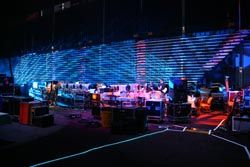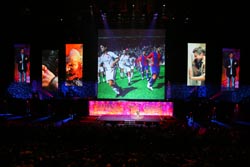LMG worked with Tencue Productions to create Autodesk's 2007 One Team Conference at the MGM Grand in Las Vegas.The tagline on the website for Autodesk's 2007 One Team Conference (OTC) read, "When you change the game, you get to rewrite the rules," to inspire the 3500 attendees made up of salespeople and resellers from across the globe. With a theme such as "Changing the Game," Autodesk turned to TenCue Productions, Inc., a full service event production and consulting company, to create a corporate meeting that would reflect this idea and rewrite the rules.
Held at the MGM Grand in Las Vegas, the meeting was designed to motivate the Autodesk team to grow sales and expand the company, despite increasing competition and market saturation, through change -- changing how they sell, to whom they sell, and what they sell. To bring this message to life, TenCue Productions wanted to create a completely different experience for the audience from a typical sales conference.
Thinking Big
TenCue turned to LMG Inc., a national provider of video, audio, and lighting, early in the planning process to create an event with scale and drama, executed in a way that had never been done. In previous years, Autodesk events have had a more traditional feel using horizontal super-widescreen as the backdrop for the speakers and presentations. This year, TenCue and LMG delivered a huge change from the norm with a 50 foot wide by 50 foot tall vertical edge blended screen at 1920 x 1920 resolution. "We wanted to overwhelm the audience with an experience that would be memorable and dramatically illuminate the conference goals," says Jeffrey Wilk, executive producer for TenCue Productions. "LMG was integral to the planning process. After we came up with the initial idea, we needed to know what was feasible, if it was even possible at that resolution."

TenCue and LMG delivered a huge change from the norm with a 50 foot wide by 50 foot tall vertical edge blended screen at 1920 x 1920 resolution.
Getting It Done
The planning process took about six months, with the first two for concept development and the last four in technical production. The concept was very risky. First, the technology for accomplishing this type of vertical blend, at that high of a resolution, is relatively new. Second, if the screens had failed to rise from the stage, Autodesk did not have a show. In addition, the setup time for this event presented quite a challenge - venue conflicts only allowed for one day of installation, and one day for fine tuning before rehearsal.
The main element of the show, the 50 x 50 foot screen, was accomplished with four Digital Projection, 35 HD projectors, each outputting a resolution of 1920 x 1080 for the top and bottom of the screen, with an overlap of 240 pixels. The graphics, created in a 1920 x 1920 resolution, were controlled by Analog Way's Di-VentiX switcher and fed through a multiple head computer to split the image to the top and bottom of the screen. "A resolution of 1920 x 1920 is very non-standard for an event, but it was necessary to appropriately display the images on a screen of that size," says Neil Morrison, video services manager for LMG.
Additionally, the five 24 x 10 foot banner screens that supplemented the main screen were independently sourced and also outputted with two sets of double-stacked 35 HD projectors. Each set of projectors for these banners displayed one 16x9 image that was split across the screens, with the areas between each banner filled in with black. Image placement was critical, particularly for the banner screens on each end that were used for vertical image magnification. The camera technicians had to pay special attention to the slightest movement of the speakers.
Vertical vs. Horizontal - Worth the Risk?
As mentioned above, vertical edge blending, as opposed to the more traditional horizontal widescreen or super-widescreen, is a newer technology and can present a risk. Horizontal edge blending has been used by the staging industry for a number of years, and there are well-developed hardware and software solutions available. The technology for horizontal widescreen has gone through an evolution over the last 8-10 years -- from the CanvasMaster to Montage, to the current solutions such as the Spyder and Encore -- and it is very mainstream in the staging environment.

LMG had a tested solution and method for achieving this type of blend with the Analog Way Di-VentiX switcher, and that became a working template for the "how to" in producing a show of this type.
In addition, graphic designers and technicians have many years of experience with horizontal widescreen and super-widescreen. Most production companies have a perfected model for creating media and graphics for horizontal widescreen, and they simply adapt it for their particular application. With a vertical blend, the approach to design and signal flow is very different -- there is no defined model for working in a vertical environment. With Autodesk, TenCue and LMG realized they were breaking new ground together. "Communication was the key. We worked very closely with the preproduction team to make sure the graphics met the playback and display environment," says Morrison.
High Risk, High Reward
In the end, the show was pulled off successfully, and everyone was thrilled with the results. The screen effectively displayed Autodesk's messaging as well as the fully rendered design capabilities of their products. The technical team ran into challenges onsite, particularly with the time constraints of the setup process, but everything came together and it worked. "When you put together a show that is new and different, you learn through the process. While the show was a success, we aren't claiming it was simple or without challenges," says Les Goldberg, CEO and president of LMG.
An important factor in the success was the cohesiveness of the team. With the ambitious schedule and new technology, onsite changes were needed to accommodate the environment. "I've worked with the same team for many years, and when difficulties arise, we trust each other that we'll figure it out, even if that involves making changes in real time," says Wilk.
The concept of this show -- the size and shape, the resolution, the execution -- broke new ground in the corporate meeting environment. "A show that literally builds up, from nothing, is not something an audience sees every day. The reaction was tremendous," explained Wilk. "Autodesk still talks about the show months later. And sales continue to grow." For more information visit www.lmg.net.










